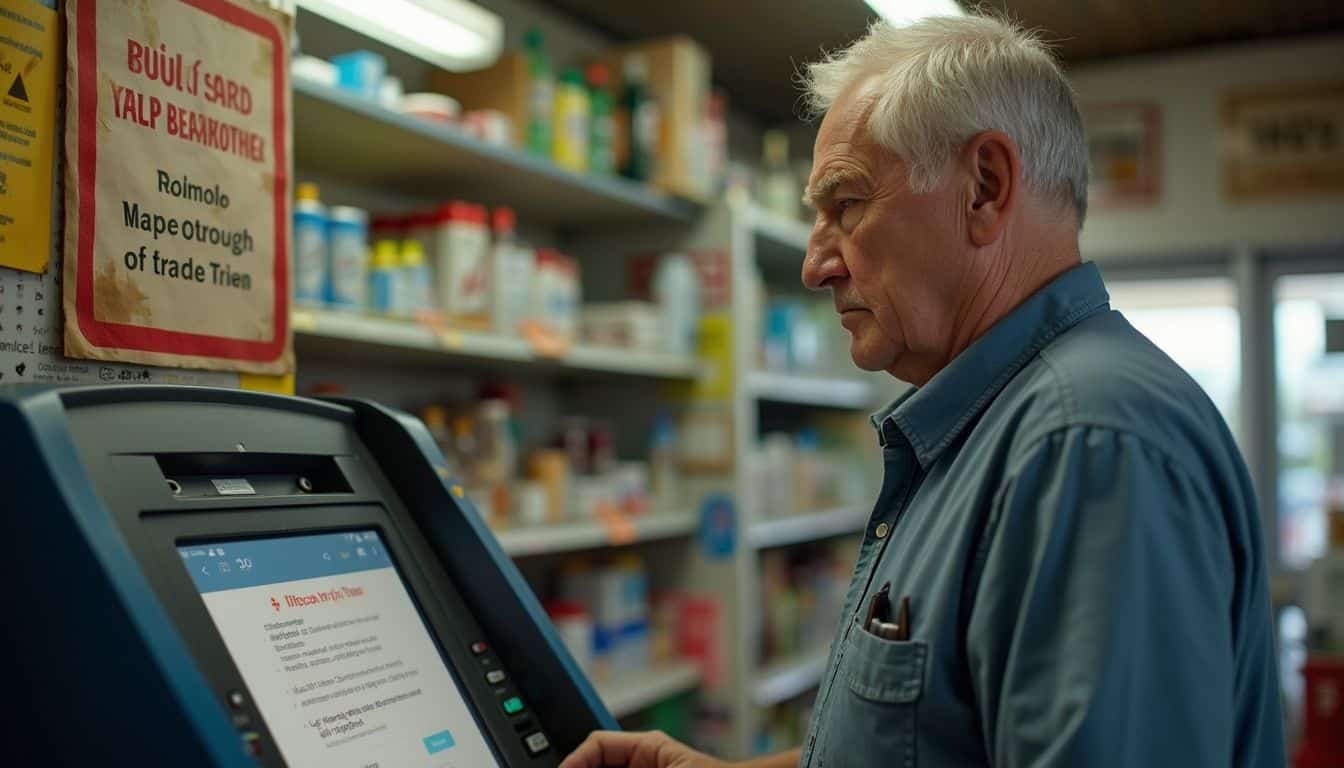Ever walked past a Bitcoin ATM and thought about using it, but then hesitated, wondering, “are Bitcoin ATMs safe?” You’re definitely not the only one.
It’s a valid question, especially when you hear stories about scams. The Federal Trade Commission reported that people lost over $65 million to crypto ATM fraud in just the first half of 2024 alone.
That sounds pretty scary, I know.
But here’s the good news. Using these machines can be safe if you know what to look for and how to protect yourself. I’m going to walk you through the risks, share some simple tips, and show you exactly how to spot the good guys from the bad guys. Let’s make sure your digital wallet stays protected.
Key Takeaways
Scammers are a major risk, with the FBI reporting a huge jump in incidents since 2020; the FTC says fraud losses hit $65 million in the first half of 2024. A 2024 FBI report highlighted that seniors lost a record-breaking $4.8 billion to online scams, with a significant portion involving crypto ATMs.
Watch out for high fees. Most Bitcoin ATMs charge between 5% and 20% for each transaction, which is way more than the sub-1.5% fees you’d find on major crypto exchanges like Coinbase or Kraken. You’ll also pay network fees that can range from $3 to $10.
Legit operators like Bitcoin Depot or CoinFlip are registered as Money Services Businesses (MSBs) with FinCEN and follow the Bank Secrecy Act. They usually display license information, have clear compliance policies, and use security features like two-factor authentication.
The new Crypto ATM Fraud Prevention Act of 2025 is here to help. It brings stricter ID checks, caps on initial deposits for new users, and requires clear fraud warnings on every machine.
To stay safe, always use FinCEN’s MSB database to verify an operator is registered. Choose well-lit, public locations like grocery stores, and be wary of anyone rushing you to send cryptocurrency.
Table of Contents
What is a Bitcoin ATM?
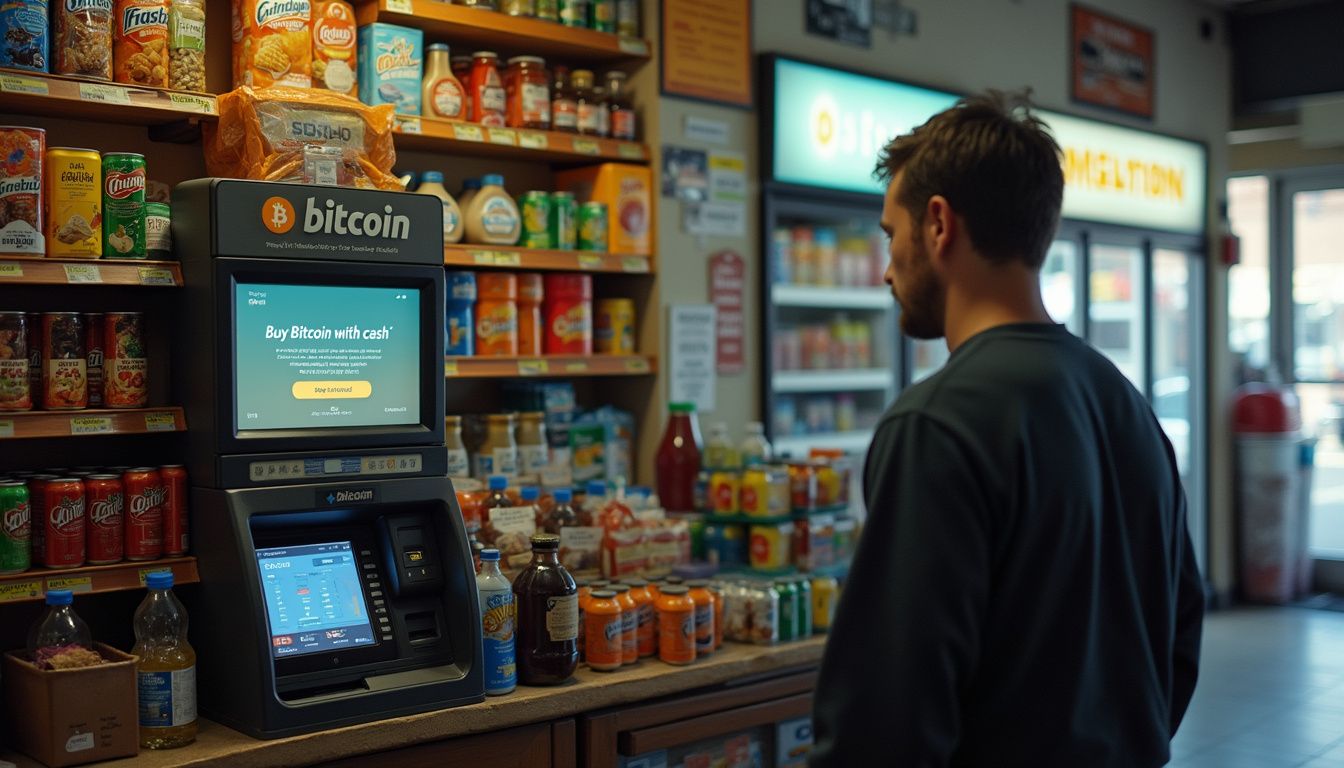
Think of a Bitcoin ATM as a specialized kiosk that connects you to the world of cryptocurrency. These machines let you buy or sell Bitcoin and other digital coins using cash or a debit card.
Unlike a regular ATM that gives you physical cash, a Bitcoin ATM sends the crypto you buy directly to your digital wallet. Most of these machines are one-way (for buying only), but you’ll find some two-way models that let you sell your crypto for cash, too.
As of mid-2024, there were over 31,000 crypto ATMs around the world, with about 80% of them right here in the U.S. You’ve probably seen them in gas stations, convenience stores, and malls. The market is led by major operators like Bitcoin Depot, CoinFlip, and Bitstop.
One of the biggest draws is that you often don’t need a traditional bank account. According to a 2024 Federal Reserve report, about 6% of U.S. adults are “unbanked,” making these ATMs a key access point to the digital economy. For small transactions, some machines might only ask for a phone number, but for larger amounts, they’ll require ID to comply with anti-money laundering rules. If you’re looking for an example, you can check out this Miami Bitcoin ATM.
“A Bitcoin ATM puts digital currency at arm’s reach for anyone with cash and curiosity.”
How do Bitcoin ATMs work?
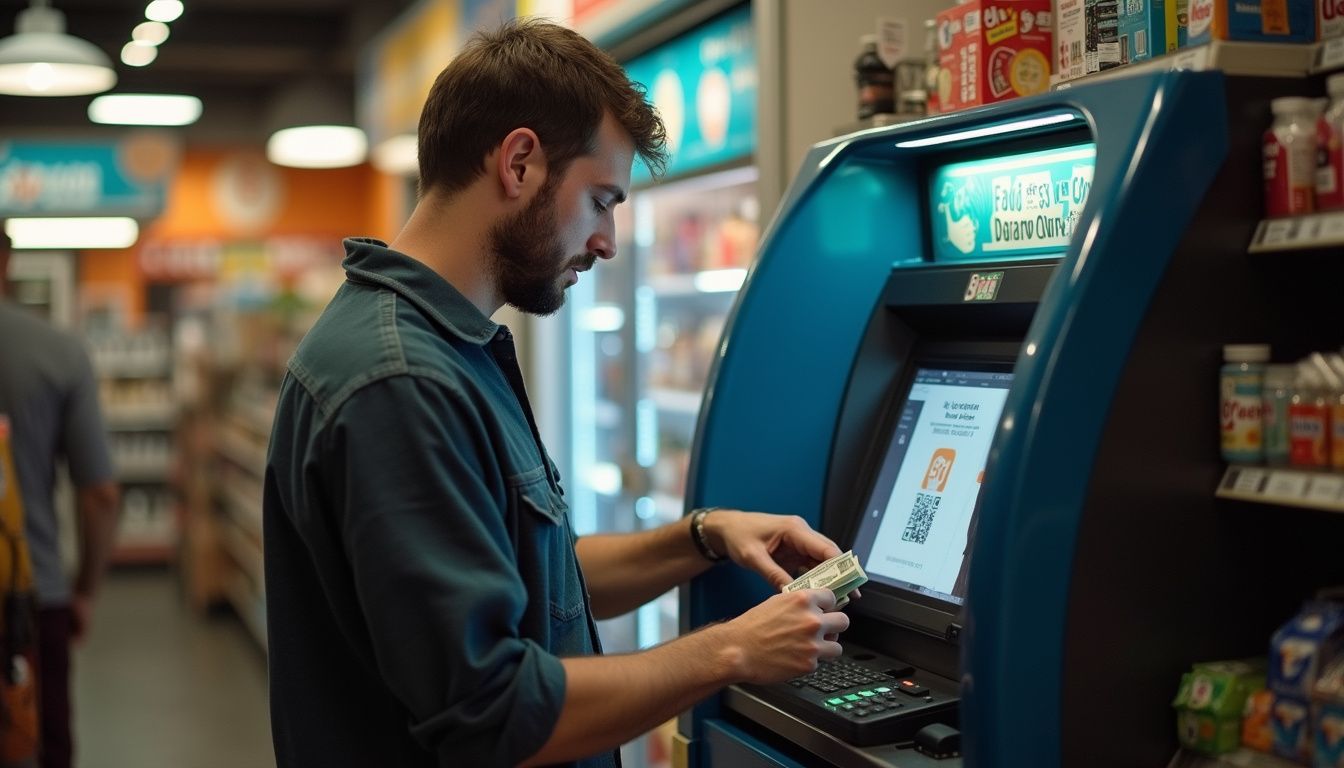
Using a Bitcoin ATM feels a lot like using a regular one, but instead of interacting with your bank account, you’re interacting with the blockchain. First thing’s first, you need a digital wallet ready to go. You can set one up with user-friendly apps like Coinbase Wallet or Trust Wallet, which give you full control over your private keys.
When you get to the machine, you might be asked for ID verification, especially for larger transactions. This could be as simple as entering your phone number for a verification text or as thorough as scanning your driver’s license.
Next, you’ll choose what you want to do. If you’re buying Bitcoin, you’ll insert cash or use your debit card. If you’re selling, you’ll specify the amount and send Bitcoin from your own wallet to the QR code address shown on the ATM’s screen.
You’ll then either scan your wallet’s QR code or manually type in the address to tell the machine where to send the coins. Most transactions are completed in just a few minutes.
A quick heads-up on something important: the fees. Bitcoin ATM fees can be steep, often ranging from 5% to a hefty 20% per transaction. On top of that, you’ll have to pay the Bitcoin network fee, which can be anywhere from three to ten dollars. There are also daily limits, which can be as low as $100 or as high as $25,000 for users who complete extra Know Your Customer (KYC) checks, as required by the Financial Crimes Enforcement Network (FinCEN).
Pros and Cons of Bitcoin ATMs
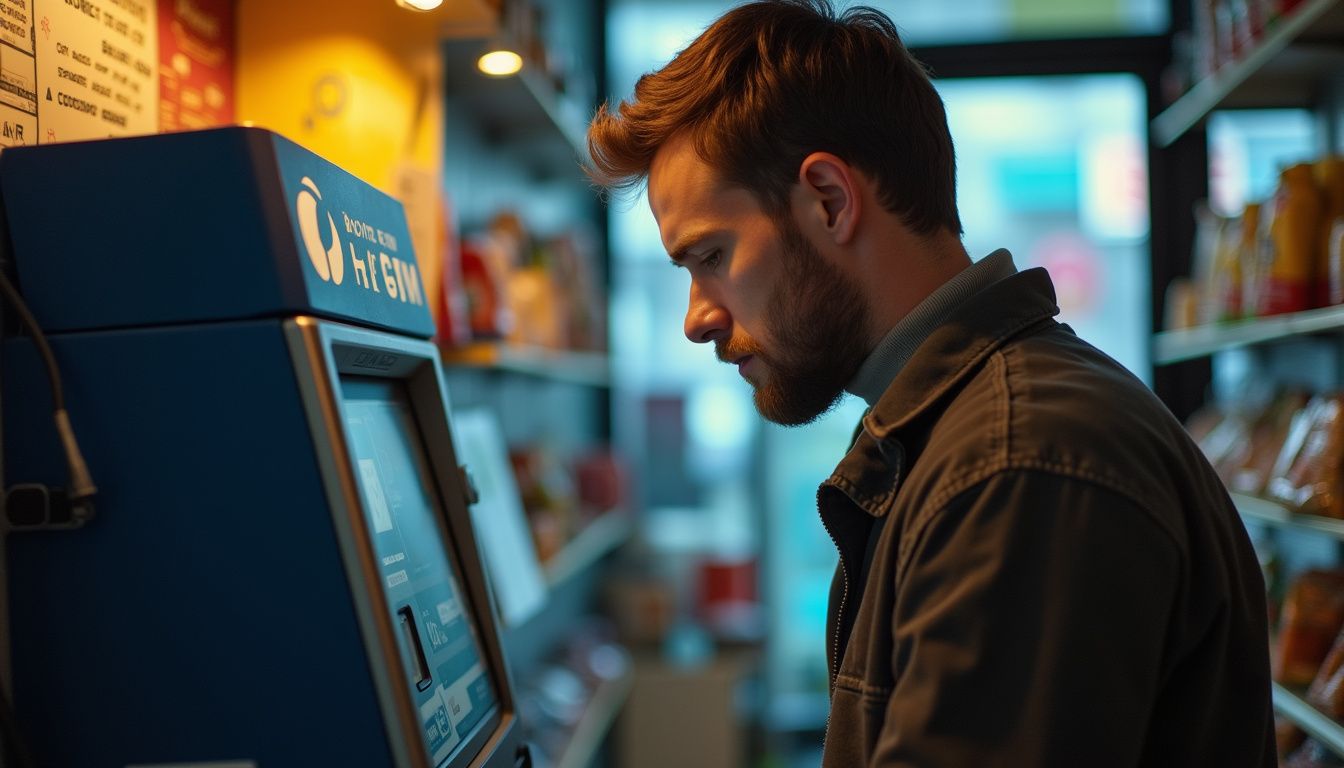
Bitcoin ATMs offer a super-fast way to buy crypto with cash, but the convenience comes with some serious trade-offs. It’s a good idea to weigh the benefits against the risks before you dive in.
What are the advantages of using Bitcoin ATMs?
One of the biggest pros is accessibility. You can deposit cash straight into a Bitcoin ATM, which is a huge deal for people who don’t have bank accounts. In 2023, the FDIC reported that 4.2% of U.S. households were unbanked, and these machines offer them a direct entry into the digital economy.
Transactions are also incredibly fast, usually finishing up in just a few minutes. That speed beats the waiting times for wire transfers or even some online cryptocurrency exchange approvals.
You get a good amount of privacy, too. For smaller transactions, often under $900, many machines don’t require a full ID verification, which appeals to many in the crypto space. And because the machine shows you the real-time exchange rates upfront, you know exactly what you’re paying before you confirm the transaction.
“You can walk into a convenience store with twenty bucks and walk out holding blockchain power in your pocket.”
The whole process is designed to be user-friendly. The touch screens guide you through each step, so you don’t need any expert market knowledge to get started. Just bring some cash and your phone, and you’re good to go.
What are the disadvantages of Bitcoin ATMs?
The most painful drawback is the high fees. Bitcoin ATMs are known for charging anywhere from 5% to 20% on top of the crypto price. When you compare that to online exchanges, the difference is massive.
| Platform | Average Transaction Fee |
|---|---|
| Bitcoin ATM | ~12% (can be up to 20%) |
| Coinbase | 0.5% – 3.99% (depending on payment method) |
| Kraken | 0.16% – 0.26% (maker/taker fees) |
Beyond the cost, financial scams are a huge problem. According to a September 2024 report from the Federal Trade Commission (FTC), there has been a “massive increase” in losses from Bitcoin ATM scams. Once you send Bitcoin, the transaction is irreversible, meaning if you get scammed, that money is likely gone for good.
You also have fewer choices. Most machines at a Bitcoin Depot or local gas station will only offer a few major cryptocurrencies, unlike an online exchange that might list hundreds. Finally, a data breach at an operator could expose your personal information, adding another layer of risk.
Common Security Concerns with Bitcoin ATMs
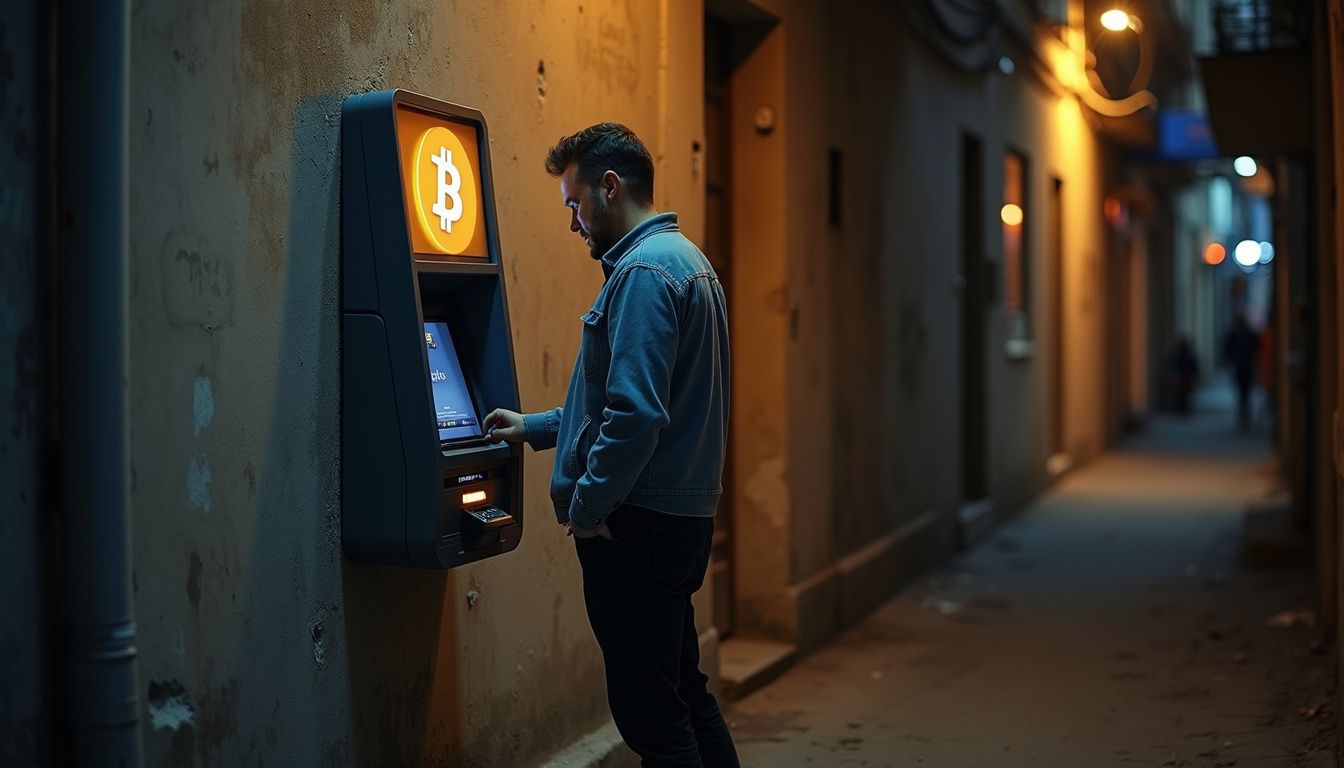
Scammers absolutely love Bitcoin ATMs because transactions are fast and can’t be reversed. They use all sorts of tricks, from fake QR codes to impersonation scams, to fool people into sending them money.
How common are scams and fraud with Bitcoin ATMs?
Unfortunately, they are incredibly common and getting worse. The Federal Trade Commission reported that Americans lost over $65 million to Bitcoin ATM scams in the first six months of 2024 alone. The FBI also noted a 1,000% increase in these incidents since 2020.
Seniors are often the primary targets. The FBI’s 2024 Internet Crime Report revealed that adults over 60 lost a staggering $4.8 billion to online scams, with nearly $250 million of that funneled through crypto ATMs. In one heartbreaking case, an 85-year-old woman named Fran Bates lost $40,000 after a scammer convinced her to deposit cash into a Bitcoin ATM.
Scammers use a few common playbooks:
- Impersonation Scams: They’ll pose as someone from the government, like the IRS or Social Security, or a tech support agent from a company like Microsoft. They create a sense of urgency, telling you to pay a fine or “secure” your money by sending it via a Bitcoin ATM.
- Romance Scams: A scammer builds a relationship with someone online and then creates a fake emergency that requires an urgent crypto payment.
- QR Code Swapping: In some cases, fraudsters place a sticker with their own wallet’s QR code over the machine’s legitimate one, tricking you into sending funds to them.
Because of these risks, it’s critical to know how to verify that the machine and its operator are legitimate.
How can you verify if a Bitcoin ATM operator is legitimate?
The most important step is to check if the operator is registered as a Money Services Business (MSB) with FinCEN (Financial Crimes Enforcement Network). This registration is required by federal law and needs to be renewed every two years. You can search for any operator directly on the FinCEN MSB Registrant Search page.
Legitimate operators will also be transparent about their compliance with the Bank Secrecy Act and Anti-Money Laundering (AML) rules. Look for a compliance officer’s name, information about their Know Your Customer (KYC) process, and clear consumer protection policies on their website. Many reputable Bitcoin ATM operators, like Bitcoin Depot, also display license information directly on their machines.
If an operator seems hesitant to share this information or if their machine is in a poorly maintained location, it’s a major red flag.
“You wouldn’t trust anyone with your digital wallet or PIN codes—don’t trust an unverified ATM either.”
How to Stay Safe When Using Bitcoin ATMs
Staying safe is all about being prepared and staying skeptical. A few simple checks can make all the difference in protecting your crypto and your personal information.
How do you verify a Bitcoin ATM operator’s reputation?
Start by checking if the operator is registered as an MSB with FinCEN. Next, use online directories like CoinATMRadar to look up the operator. These sites often have user reviews where you can see what others have said about their bitcoin atm fees and customer service.
Dig a little deeper by visiting the operator’s official website. Reputable companies like CoinFlip and Bitcoin Depot are very open about their security measures. They’ll have dedicated pages explaining their AML policies, refund processes, and how they protect your data. A company that is transparent and easy to contact is usually a good sign.
Also, check if they use tamper-resistant hardware and security features like two-factor authentication. An operator that invests in security is one that values its customers’ safety.
How can you avoid suspicious transactions at Bitcoin ATMs?
The golden rule is to never send cryptocurrency to someone you don’t know or trust. Scammers often create a sense of extreme urgency, pressuring you to act fast before you have time to think. If someone is telling you to go to a Bitcoin ATM to fix a problem with your bank account, pay a fine, or claim a prize, it is almost certainly a scam.
I always make it a habit to double-check the recipient’s wallet address. Before you hit send, use a blockchain explorer like Blockchain.com to see the transaction history of the address. Tools like Chainabuse can also tell you if an address has been reported for fraudulent activity.
Here are a few other quick tips:
- Stick to small amounts first. If you’re using a machine for the first time, do a small test transaction to make sure everything works as expected.
- Never let a stranger “help” you. Scammers will hang around ATMs and offer assistance, only to trick you into sending funds to their wallet.
- Fill out all identity verification prompts accurately. Skipping steps could get your transaction flagged or frozen under Bank Secrecy Act (BSA) monitoring.
Why should you use Bitcoin ATMs in secure locations?
The physical location of the ATM matters a lot. I once saw a machine in a dimly lit corner of a 24-hour gas station that had a hand-written “Out of Order” sign taped to it, which felt incredibly sketchy. Scammers and thieves target machines in isolated or poorly monitored areas.
Choosing a Bitcoin ATM in a well-lit, high-traffic location like a major grocery store, mall, or even a bank lobby can significantly reduce your risk. These places usually have security cameras and staff present, which deters criminals from tampering with the machine, like installing card skimmers or fake QR codes.
Reputable operators often partner with well-known retail chains. Using a machine in a trusted environment makes it less likely you’ll encounter a compromised device or become a target for physical theft.
Compliance and Regulation of Bitcoin ATMs
The days of Bitcoin ATMs operating in a regulatory gray area are coming to an end. Government agencies are stepping in to create a safer environment for users and crack down on financial crimes.
What federal compliance standards apply to Bitcoin ATMs?
In the United States, Bitcoin ATM operators are classified as Money Services Businesses (MSBs), which means they are regulated by FinCEN. This requires them to follow the rules of the Bank Secrecy Act (BSA).
This isn’t just a suggestion, it’s the law. Here’s what it means for them:
- Register with FinCEN: All operators must register and renew their status every two years.
- Appoint a Compliance Officer: They need to have a specific person responsible for making sure all the rules are followed.
- Maintain Records: They must keep detailed transaction records for at least five years.
- Report Suspicious Activity: Operators are required to file Suspicious Activity Reports (SARs) with FinCEN for any transaction that seems fishy, and Currency Transaction Reports (CTRs) for transactions over $10,000.
These regulations are why you’re seeing more robust ID verification at these machines. Failing to comply can lead to massive fines and even criminal charges for the operators.
What are the Anti-Money Laundering (AML) requirements for Bitcoin ATMs?
Anti-Money Laundering (AML) rules are a core part of the compliance puzzle. Operators like Bitcoin Depot must have a comprehensive AML program in place to prevent their machines from being used for illegal activities.
This includes conducting real-time identity checks, a process known as Know Your Customer (KYC). For any transaction over $1,000, they typically need to perform enhanced due diligence, which might involve asking for more detailed personal information.
The upcoming Crypto ATM Fraud Prevention Act of 2025 is set to make these rules even stricter. This new law will mandate stronger consumer protections and more rigorous ID verification across the board, aiming to curb the rampant scams that have plagued these machines.
How will Bitcoin ATMs change in 2025?
You can expect Bitcoin ATMs to become much more secure and regulated in 2025. With the U.S. crypto ATM market projected to grow at a staggering 55% compound annual growth rate between 2025 and 2032, regulators are paying close attention.
The Crypto ATM Fraud Prevention Act is the biggest driver of this change. Once fully implemented, every kiosk will be required to display clear fraud warnings and perform strict identity checks for all users. For new customers, there will be daily transaction limits capped at $2,000 and a requirement for live, verbal confirmation for any transaction over $500.
This means the days of anonymous, high-value transactions at shady gas station Bitcoin ATMs are numbered. Operators will need to be fully registered as money services businesses, with robust anti-money laundering checks and consumer protection measures in place.
I’ve already noticed a shift. The last time I used a Bitcoin Depot ATM, the on-screen prompts included multiple warnings about common financial scams. It even made me pause and double-check my bitcoin wallet address, which is exactly the kind of friction that can prevent a costly mistake.
If you’re curious about how this fits into the bigger picture, you can read more about global Bitcoin adoption.
People Also Ask
Are Bitcoin ATMs safe to use at gas stations or convenience stores?
Bitcoin ATMs can be safe if you use reputable operators in well-lit locations, but watch out for physical tampering like skimmers or fake QR codes meant to divert your funds. Always check that the machine belongs to a known company like Bitcoin Depot or CoinFlip before using it.
What are the most common bitcoin ATM scams I should watch out for in 2025?
Watch for government impersonation, romance scams, and fake “pig butchering” investment schemes where you are pressured to send crypto immediately. According to the FBI, these cryptocurrency investment frauds are the most prevalent and costly scams currently active.
How do I protect my digital wallet when using a bitcoin ATM?
Use a dedicated, secure “hot wallet” for ATM transactions and transfer your main holdings to a hardware wallet like a Ledger or Trezor for long-term safety. Always enable two-factor authentication on your wallet app and never share your private keys with anyone.
Why are bitcoin ATM fees higher than online crypto exchanges?
Operators charge high fees, often between 7% and 20%, to cover the costs of handling physical cash, machine maintenance, and strict compliance with regulations from bodies like FinCEN. These compliance costs include mandatory registration as a Money Services Business (MSB) and implementing anti-money laundering programs.
Can I use a home equity loan or HELOC at a Bitcoin ATM?
No, Bitcoin ATMs are designed only for converting physical cash into cryptocurrency and do not connect to bank accounts or lines of credit like a HELOC.
What rules will change for Bitcoin ATMs in 2025 regarding consumer protection?
Regulators are enforcing stricter Know Your Customer (KYC) protocols based on the Financial Action Task Force (FATF) “Travel Rule,” which will require more detailed user identification for transactions over certain thresholds. This is part of a broader effort by agencies like FinCEN to increase transparency and combat financial crimes.
References
https://www.bankrate.com/banking/what-are-bitcoin-atms/ (2025-09-15)
https://www.osl.com/hk-en/academy/article/bitcoin-atms-how-to-use-them-and-how-do-they-work
https://www.ka.app/learn/are-bitcoin-atms-safe (2024-12-18)
https://www.cnbc.com/2024/09/08/biggest-risks-of-accessing-crypto-through-bitcoin-atm.html
https://www.orderexpress.com/understanding-the-benefits-and-drawbacks-of-bitcoin-atm/ (2025-07-16)
https://www.cnn.com/interactive/2025/10/us/crypto-atm-scams-companies-profit-invs-vis/
https://www.orderexpress.com/is-bitcoin-atm-secure-know-the-risks-and-how-to-stay-safe-2/ (2025-07-10)
https://www.orderexpress.com/bitcoin-atm-safety-what-you-need-to-know-before-using-one/ (2025-06-12)
https://www.orderexpress.com/is-bitcoin-atm-secure-know-the-risks-and-how-to-stay-safe/ (2025-07-10)
https://cointimeatm.com/bitcoin-atm-regulations-and-compliance/ (2024-11-20)
https://coincub.com/bitcoin-atm-laws/ (2025-09-16)
https://www.fincen.gov/system/files/shared/FinCEN-Notice-CVCKIOSK.pdf
